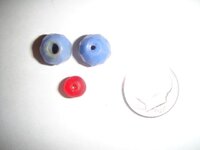unclemac
Gold Member
- Oct 12, 2011
- 7,258
- 7,385
- Primary Interest:
- Beach & Shallow Water Hunting
What's your technique?
What tips do you have for hunting? For me on the beach I would look for signs of habitation...broken salt glazed pottery, broken bricks, cork top bottle necks etc. and then start hunting the site. I also would look for a year round fresh water supply...some sort of stream and a sheltered point that would break up the waves a bit. Of course this was in the old days before it was illegal to pick up artifacts.
In the outback we would look for dry washes...most of the outback is one big desert but just like Arizona, flash floods come quick and violent. After you find a good wash you look for a bend that would hold water a bit longer than the rest of the bed. Usually at these points you would get a small grove of gum trees. The thought here was two fold, one...a wounded animal goes to water, and two shade from the sun in a desert is a good place to sit a spell and chip tools.
In the Nevada/Utah deserts we would walk the shallow rivers...look for old pioneer and stage coach trails and follow along. Or you look for a point of land on the side of a range of hill....something about half way up the hill that sticks out and gives you a good view of anyone coming in any direction. These places would often have rings of rocks under the scrubby junipers made as sleeping platforms and lots of flakes and scrapers.
Of course in Illinois (Midwest farm country) just follow along a plowed row after a rain!
How about you guys?
What tips do you have for hunting? For me on the beach I would look for signs of habitation...broken salt glazed pottery, broken bricks, cork top bottle necks etc. and then start hunting the site. I also would look for a year round fresh water supply...some sort of stream and a sheltered point that would break up the waves a bit. Of course this was in the old days before it was illegal to pick up artifacts.
In the outback we would look for dry washes...most of the outback is one big desert but just like Arizona, flash floods come quick and violent. After you find a good wash you look for a bend that would hold water a bit longer than the rest of the bed. Usually at these points you would get a small grove of gum trees. The thought here was two fold, one...a wounded animal goes to water, and two shade from the sun in a desert is a good place to sit a spell and chip tools.
In the Nevada/Utah deserts we would walk the shallow rivers...look for old pioneer and stage coach trails and follow along. Or you look for a point of land on the side of a range of hill....something about half way up the hill that sticks out and gives you a good view of anyone coming in any direction. These places would often have rings of rocks under the scrubby junipers made as sleeping platforms and lots of flakes and scrapers.
Of course in Illinois (Midwest farm country) just follow along a plowed row after a rain!
How about you guys?
Upvote
0







